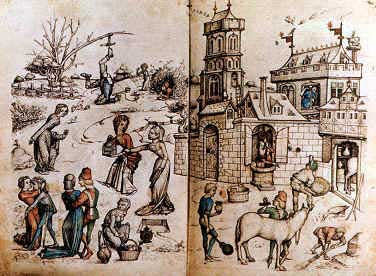Fulgour
I can easily see The Hanged Man as a Gypsy violinist,
hanging from the rafters and playing behind his back.
But then there are many mainstream possibilities with
the presentation of a Knight, being taught a lesson...
... Il a donc une activité utile, bénéfique~
Il a été capable de dompter la sauvagerie.
*
Perhaps our story began when...
... Hugh de Payens and eight other knights took vows
on June 12, 1118 at Arginy Castle near Lyons, France.
*
BAFFLE: a punishment or degradation of a recreant Knight,
including hanging him or his effigy by the heels from a tree.
*
Baffle 1548, "to disgrace," perhaps a Scottish respelling of bauchle
"to disgrace publicly" (especially a perjured knight), prob. related to
Fr. bafouer "to abuse, hoodwink," possibly from baf, a natural sound
of disgust, like bah. Meaning "to bewilder, confuse" is from 1649;
that of "to defeat someone's efforts" is from 1675. The noun sense
of "shielding device" is first recorded 1881.
http://www.etymonline.com/index.php?term=baffle
*
[1913 Webster]
Baffle \Baf"fle\ (b[a^]f"f'l), v. t.
[imp. & p. p. Baffled (-f'ld); p. pr. & vb. n. Baffling (-fl[i^]ng).]
[Cf. Lowland Scotch bauchle to treat contemptuously, bauch tasteless,
abashed, jaded, Icel. b[=a]gr uneasy, poor, or b[=a]gr, n., struggle,
b[ae]gja to push, treat harshly, OF. beffler, beffer, to mock, deceive,
dial. G. b["a]ppe mouth, beffen to bark, chide.]
To cause to undergo a disgraceful punishment, as a recreant knight.
*
He by the heels him hung upon a tree,
And baffled so,
that all which passed by
The picture of his punishment might see.
Sir Edmund Spenser
hanging from the rafters and playing behind his back.
But then there are many mainstream possibilities with
the presentation of a Knight, being taught a lesson...
... Il a donc une activité utile, bénéfique~
Il a été capable de dompter la sauvagerie.
*
Perhaps our story began when...
... Hugh de Payens and eight other knights took vows
on June 12, 1118 at Arginy Castle near Lyons, France.
*
BAFFLE: a punishment or degradation of a recreant Knight,
including hanging him or his effigy by the heels from a tree.
*
Baffle 1548, "to disgrace," perhaps a Scottish respelling of bauchle
"to disgrace publicly" (especially a perjured knight), prob. related to
Fr. bafouer "to abuse, hoodwink," possibly from baf, a natural sound
of disgust, like bah. Meaning "to bewilder, confuse" is from 1649;
that of "to defeat someone's efforts" is from 1675. The noun sense
of "shielding device" is first recorded 1881.
http://www.etymonline.com/index.php?term=baffle
*
[1913 Webster]
Baffle \Baf"fle\ (b[a^]f"f'l), v. t.
[imp. & p. p. Baffled (-f'ld); p. pr. & vb. n. Baffling (-fl[i^]ng).]
[Cf. Lowland Scotch bauchle to treat contemptuously, bauch tasteless,
abashed, jaded, Icel. b[=a]gr uneasy, poor, or b[=a]gr, n., struggle,
b[ae]gja to push, treat harshly, OF. beffler, beffer, to mock, deceive,
dial. G. b["a]ppe mouth, beffen to bark, chide.]
To cause to undergo a disgraceful punishment, as a recreant knight.
*
He by the heels him hung upon a tree,
And baffled so,
that all which passed by
The picture of his punishment might see.
Sir Edmund Spenser



